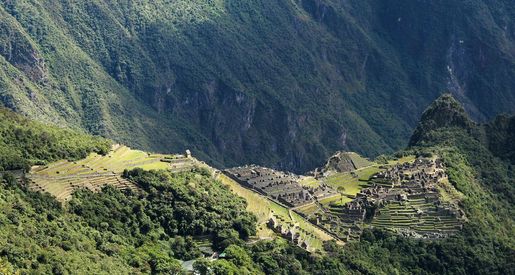- Details
- Category: Knowledge Centre
The beginner's guide to the inca trail hike
Welcome to the beginner's guide to the Machu Picchu via the Inca Trail hike!
This absolute classic of a hike combines the acclimatization day of another route we use, as well as taking the tough route over Dead Womens Pass at almost 4200m. You'll hike through Incan ruins, journey through ancient forests and along numerous scenic mountain valleys before you finally reach the BIG HIGHLIGHT of the trip, the famous citadel of Machu Picchu.
So, are you a beginner looking at this awesome adventure? There’s a lot to think about right?
Well don’t worry, we got you! Here’s everything you need to know about this famous route!
What is the Inca Trail?
This is a legendary 5 day hike that follows ancient stone paths crafted by the Incas centuries ago. It starts at the awesome Sacred Valley outside of Cusco, and ends at the mystical Intipunku 'Sun Gate' at Machu Picchu. You can also visit Machu Picchu on our awesome Tomacaya Route. The ancient Inca Trail route is 43 km (26 miles) and takes 5 days on our special itinerary, with room for acclimatization and days to explore and take in the amazing culture (10 days altogether). After all, it’s not just about the hike!
The path to Warmiwañusca (aka Dead Woman’s Pass) is the highest point of this trek at 4,198m (13,769 ft). This high pass is definitely something to tick off the bucket list and you’re not even at the highlight of this hike yet!
This adventure certainly leaves its mark and the memories will last a lifetime.
Is the Inca Trail Hike for Beginners?
Absolutely! Despite its reputation as a challenging trek, the Machu Picchu hike is accessible to hikers of all levels, including beginners. With the right preparation and mindset, anyone can conquer this legendary trail and experience the awe-inspiring wonders of the Inca civilization. Keep in mind there are a fair few steps on this famous trail. Apparently there are around 70,866! But we’ll let you count them for yourselves when you go!
What You’ll See Along the Inca Trail
Along this ancient trail there's stunning scenery and ancient ruins. Lush cloud forests and towering peaks to ancient Inca temples and fortresses, and every step of the journey offers something new and exciting to discover, no matter which route you choose. If you love a bit of ancient history and culture, this is the one for you!
essential things to know before hiking machu picchu
When is the best time to hike the Inca Trail?
The best time to hike the Inca trail is between May and October when the weather is dry and the trail is less crowded. Permits are slightly less hard to obtain by us at this time due to lower numbers.
The Festival of the Sun (Inti Raymi) typically occurs towards the end of June, drawing in crowds to Cusco as people make their way to Machu Picchu. Another peak period for hikers is Peru's national holiday at the end of July, with many choosing to tackle the Inca Trail or visit Machu Picchu via train. The dry weather remains decent for tourists throughout August and carrys on into September, making it a popular time to visit.
As November arrives, the rainy season kicks off, although trekking conditions can still be ok and the crowds are a little less compared to the summer months.
December brings wet weather and an influx of tourists due to the holiday time, resulting in busy accommodation and flight costs despite the less-than-ideal weather conditions. But January sees a descrease in crowds, although it remains wet, making it a quieter period to visit without the holiday rush.
What permits do I need for the Inca Trail?
You can't hike the Inca trail without a permit or an entrance fee, EverTrek will have this sorted for you on the trek as part of your trip cost.
But what are permits for?
- Ensuring conservation and upkeep of the Inca Trail
- Implementing measures for environmental protection
- Safeguarding the cultural heritage of the trail's ancient sites
- Managing crowd levels effectively
- Supporting local community development initiatives including education and infrastructure projects
- Covering administrative expenses
With the Inca trail permits, It’s never too soon to send us your passport info once you have booked your trek. We need this information for obtaining them in good time and are needed as early as possible! The Machu Picchu site is a busy one and we don’t want anyone missing out on their once in a lifetime adventure - once they’re gone, they’re gone!
Permits are easier to get on our lesser known, quieter Tomacaya Route.
How do I Book my Flights to Machu Picchu?
Get those flights booked! Booking the wrong flight can be an expensive mistake and knowing what to do when you land can be scary, so we’ve decided to help by answering some of the most asked questions.
International flights are not included in your booking so you will need to arrange your return flight to Peru. You need to book a flight to Jorge Chavéz International Airport in Lima.
What day should I aim to arrive?
You should arrange to arrive at Lima on day 1 of your itinerary. As it generally takes longer than a day to arrive in Lima, you should book your flight to leave the UK the day before.
Where do I go once I’ve arrived in Lima?
Before you arrive in Lima, we will have made a reservation for you at the Wyndham Costa del Sol Lima Airport hotel. This is a short walk from the arrival terminal and is where you will spend the night before heading to Cusco on day 2 of your itinerary. Don’t worry you won’t have to do all of this alone, a member of the local EverTrek team will be there to help.
Is my flight to Cusco included?
Yes! We will arrange your return flight to Cusco and back again to Lima and be with you to make the process super easy.
What happens if I arrive early in Lima?
If you decide to arrive early in Lima, you are free to arrange your own time. All you must do is arrive back at the Wyndham Costa del Sol, (Lima Airport Hotel) on day 1 of your itinerary, recommended check in time is from 15:00.
Your room will have been booked by us so you can check in and relax for the evening, you will then need to be ready & in the lobby the next morning (usually between 08:00/08:30 on Day 2) to meet up with your group & Guide, who will escort you back to the airport to board your flight to Cusco.
What happens if I want to extend my trip and depart later than the final day?
If you wish to extend your stay in Cusco please let us know at least 90 days in advance as we will need to pre-book your return flight back to Lima. If you plan on staying longer in Lima this is no problem and we will book your flights as per the normal itinerary, once you land you are free to explore at your leisure.
What is the food & accommodation like on the Inca Trail?
On our Inca trail trek, you'll enjoy a combination of hotels and tents throughout the trip.
Your first nights accommodation will be in the 4 Star Wyndham Costa del Sol hotel conveniently located directly outside Lima Airport.
On the Trek itself you’ll be camping in tents which will be all ready and waiting for you at the end of a hard day hiking which believe me is an absolute delight!
The food on the trek can only be described as AMAZING! How the team manage to cook on a camping stove in a tent and produce fantastic meals is pretty impressive.
Here’s a sample of the type of tasty treats you can expect:
Breakfast Sample Menu: Coca tea and a range of herbal teas, hot chocolate, quinoa drink, fruit and yogurt, granola, omelet, toast and jam, juice.
Lunch Sample Menu: Grilled veg, potato and sweet potato dishes, white corn, fried rice, meat or fish.
Dinner Sample Menu: Guacamole and fresh nachos, quinoa & other soups like minestrone & vegetable, grilled meat, pasta, rice dishes, Andean pan chuta (traditional baked bread), pan fried fish. All evening meals included a starter, soup course and range of main dishes! YUM!
How fit do I need to be for the Inca Trail?
Let’s get training! While the Machu Picchu via the Inca Trail hike is accessible to beginners, it's essential to be in good physical condition before heading out on this trek. Our best advice is to put a weighted bag on your back, about 5kg (weights or water) in your backpack (or 10 kgs if you are feeling extra adventurous), and just go for it and do some miles. If you've just bought some flashy new hiking boots, wear them as much as you can! You don’t want to be uncomfortable when you’re on your adventure.
As there are so many steps on this trail…you guessed it, get on some stairs as you train! Be it stepmaster or apartment stairs, you’ll certainly be feeling it on the legs…
What is the altitude like on the Inca Trail?
The high altitude of the Andes Mountains can present challenges for some trekkers, so it's essential to acclimatize properly before beginning the hike and during. In our itineraries we include days for acclimatizing so don't panic! Plus you can always spend a few days in Cusco before setting out to allow your body to adjust.
Something you can do to test your body at altitude is to head over to the Altitude Centre in London, they have everything you need to test your fitness and to see how the body reacts at altitude. Grab your free consultation with them via your members area when you book your trek.
Top tips - Stay hydrated! Drink plenty of water. Listen to your body, listen to your guide, be honest with them about your health, and you’ll smash it!
What vaccinations do I need for Machu Picchu?
Make sure you're up to date with your vaccinations before heading off on the Machu Picchu trek. These include familiar jabs like typhoid, tetanus, and diphtheria, which are recommended every 10 years. Additionally, consider optional vaccinations such as hep B and rabies, especially if you travel regularly to regions where these diseases are present.
Remember, if you book with us then you benefit from discounted vaccinations with Nomad - find more info here.
what kit do i need for the inca trail hike?
Clothing and Gear
- Hiking boots: You will need a good pair of hiking boots which are well worn in and comfortable. The EvertTrek Yeti’s are fond of the brands Meindl, Scarpa, La Sportiva, Salamon and Salewa.
- Waterproof jacket and trousers: Be prepared for rain showers by packing lightweight waterproof outerwear. A lightweight Gore-Tex or similar jacket is essential.
- Base layers: Moisture-wicking base layers will keep you comfortable and dry during long days on the trail.
- Mid Layer / Outer Layer: The morning and evenings on the Peru Treks can be cold so packing a lightweight fleece or mid layer and down jacket is a smart way to keep yourself warm without add
- Sun hat and sunglasses: Protect yourself from the sun's rays with a wide-brimmed hat and UV-blocking sunglasses.
Essentials
- Day Pack : You’ll need a hiking backpack to carry your daily essentials, 25l to 30l combined with a hydration bladder. We recommend the Osprey Talon 33L if you prefer a specific women’s fit pack, we like the Lowe Alpine Airzone Trail or Osprey Tempest.
- Duffel bag for trek (7kg weight limit)
- Sleeping bag/mat: To reduce your packing sleeping bags and mats can be hired, an option we’d highly recommend!
- Water bladder 2lt - 3ltr or bottle: Stay hydrated on the trail by carrying plenty of water with you.
- Sunscreen: Don't forget to protect your skin from the sun's harmful rays with a high SPF sunscreen.
- Sun hat and sunglasses: That pesky sun!
- Mosquito Repellent - although the route we trek has a very low risk of malaria, mosquito bites are definitely not something you want to pick up as a souvenir! A good quality mosquito repellent with a high deet content is definitely something you’ll be glad you packed.
- Beanie Hat: For the morning and evenings when the temperature drops.
- Neck Buff: Very versatile item, great for keeping your neck, head and face warm out away from the sun and dust.
- Headlamp: For moving around camp at night and finding things in your tent when the sun goes down.
- Gloves x 2: A lightweight liner pair of gloves and a thicker insulated pair of gloves.
- Trekking Poles: These are great and very helpful for the steep trails, making the climbs easier and taking a lot of the pressure off your knees on the descents. It's worth noting to bring rubber ends to your poles for when you enter the Inca Trail section of the trek.
- First aid kit: Be prepared for minor injuries and ailments with a compact first aid kit containing essential supplies.
- Wet wipes: For a cheeky tent wash.
- Small trekking towel – For a cheeky tent dry.
- Snacks - we always recommend bringing something that will give you a boost when you are flagging, be it Haribo, energy gels or protein bars - whatever will help get you through! We escpecially love CLIF Bar for a proper boost of energy!
For a more comprehensive list, just get in touch at 02920 003216 or email This email address is being protected from spambots. You need JavaScript enabled to view it. for more recommendations.
What can I do after the Inca Trail hike?
Rainbow Mountain - This is an amazing natural wonder at an altitude of 5200m so if you are like us Yetis, it offers the perfect blend of altitude, scenery and adventure!
Want to read more about this incredible extension? View the full itinerary here!
Lake Titicaca - This is the largest lake in South America and the highest navigable lake in the world, Lake Titicaca sits at an altitude of 3,812m and offers an experience like no other.
Want to read more about this incredible extension? View the full itinerary here!
To add one of these awesome experiences onto the end of your trek, just give us a call at 02920 003216.
Are there any alternative routes to Machu Picchu?
The Machu Picchu hike via the Inca Trail is a once-in-a-lifetime adventure that promises to be both challenging and rewarding, but are there any alternate routes?
We also provide a much quieter and lesser known route called the 'Tomacaya Route'. If you want to avoid the crowds on the trail, how about trying this one?
With good preparation, mindset and humor, anyone can complete this famous trek and take in the magic of Machu Picchu.
Hit the buttons below to find out more about your next adventure.
Previous Articles
- How to Train for the Everest Base Camp Trek
- How high is Everest Base Camp?
- How much spending money do you need for the Everest Base Camp trek
- What's the accommodation like on an Everest Base Camp trek
- Are showers available on the Everest Base Camp trek?
- What type of toilets are available on an Everest Base Camp Trek






